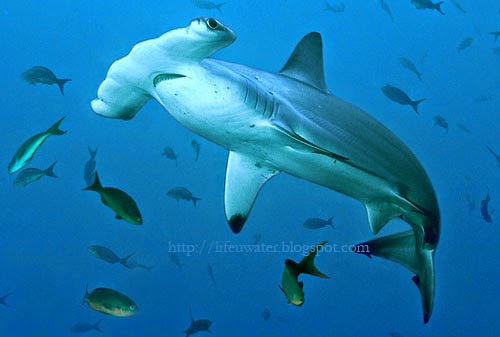Different people share various different kinds of
fear. Fear of height, fear of flight, fear of exams, fear of animals etc. This
article is about some extremely dangerous fishes around the World. Fishes are
amongst the beautiful creatures in the world. The nature has gifted us with
countless fish species. Some of them are used for eating, while others are just
kept in artificial aquariums to beautify our environment. Despite the fact that
the fishes are very beautiful, sometimes they prove to be extremely dangerous
as well. Here are the top 10 most dangerous fishes under the blue water.
The Stonefish: Synanceia or Stonefish is a genus of fish of the family
Synanceiidae, the Stonefishes, whose members are venomous, dangerous, and
even fatal to humans. It is one of the most venomous fish in the world. They
are found in the coastal regions of Indo-Pacific oceans as well as off the
coast of
|
Great White Shark: The great white shark (Carcharodon carcharias), also known as the
great white, white pointer, white shark, or white death, is a species of
large lamniform shark which can be found in the coastal surface waters of all
the major oceans. The great white shark is mainly known for its size, with
mature individuals growing up to 6.4 m (21 ft) in length (although reports
have been published of great white sharks measuring over 8 m (26 ft), and
3,324 kg (7,328 lb) in weight). Read More…
|
Black Piranha: The black piranhas have the most powerful bites of carnivorous
fishes, living or extinct, once body size is taken into account, researchers
find. The black piranha has jaw muscles of an 'extraordinary' size and a
highly modified jaw-closing lever. In fact, the muscle complex makes more
than two percent of the black piranha's total body mass. This allows the fish
to exert bite force equivalent to 30 times its bodyweight.
|
The measured bite force of the black piranha, at 320
|
Lionfish:
Pterois, commonly known as lionfish, is a genus of venomous marine. It is
characterized by red, white and black bands, showy pectoral fins and venomous
spiky fin rays. The lionfish is one of the most venomous fish on the ocean floor.
Lionfish have venomous dorsal spines that are used purely for defense. When
threatened, the fish often faces its attacker in an upside down posture which
brings its spines to bear. Read More…
|
Goliath Tiger Fish: Goliath Tigerfish, also known as the Hydrocynus
goliath, giant tigerfish or mbenga, is a very large African predatory
freshwater fish of the Alestidae family. The Goliath tigerfish puts more
energy into killing than breeding. It can take a local population between
five and 14 years to double in size. Ergo, every one you release helps ensure
that the monsters remain in adequate numbers to keep the ecosystem in stasis.
|
Bull Shark:
The bull shark (Carcharhinus leucas), also known as the Zambezi shark or,
unofficially, as Zambi in Africa and Nicaragua shark in Nicaragua, is a shark
commonly found worldwide in warm, shallow waters along coasts and in rivers. Bull
sharks have the strongest bite of any shark species, scientists have
discovered. The bull sharks have a bite force of up to 600 kilograms (1,300
lb), pound for pound the highest among all investigated cartilaginous fishes.
|
Pointed sawfish: Pointed sawfishes, also known as carpenter sharks, Smalltooth
Sawfish or Wide Sawfish, are a family (Pristidae) of rays characterized by a
long, narrow, flattened rostrum, or nose extension, lined with sharp
transverse teeth, arranged so as to resemble a saw. All species in the family
are either endangered or critically endangered. Several species of sawfishes can grow to
about 7 m (23 ft). The family as a whole is largely unknown and little
studied. The Pristidae are the only living family within the order
Pristiformes, whose name comes from the Ancient Greek. Read More…
|
Electric Eel:
The electric eel (Electrophorus electricus) is an electric fish, and the only
species in its genus. It is capable of generating powerful electric shocks of
up to 600 volts and 1 ampere of current (600 watts). It would be extremely
unlikely for such a shock to be deadly for an adult human, due to the very
short duration of an eel's discharge
|
Tiger Shark:
The tiger shark is a solitary, mostly nocturnal hunter, and is notable for
having the widest food spectrum all sharks, consuming a variety of prey
ranging from crustaceans, fish, seals, birds, squid, turtles, and sea snakes
to dolphins and even other smaller sharks. The tiger shark has been known to
eat inedible manmade objects that linger in its stomach, and it has a
reputation as a "garbage eater". When attacking, the tiger shark
often eats its prey whole, although larger prey are often eaten in gradual
large bites and finished over time. Read More...
|
Chironex (Box Jellyfish): Box jellyfish (class Cubozoa) are cnidarian
invertebrates distinguished by their cube-shaped medusae. Stings from these
and a few other species in the class are extremely painful and sometimes
fatal to humans. A few species of Chironex (Box Jellyfish) have been
confirmed to be involved in human deaths.
|






































